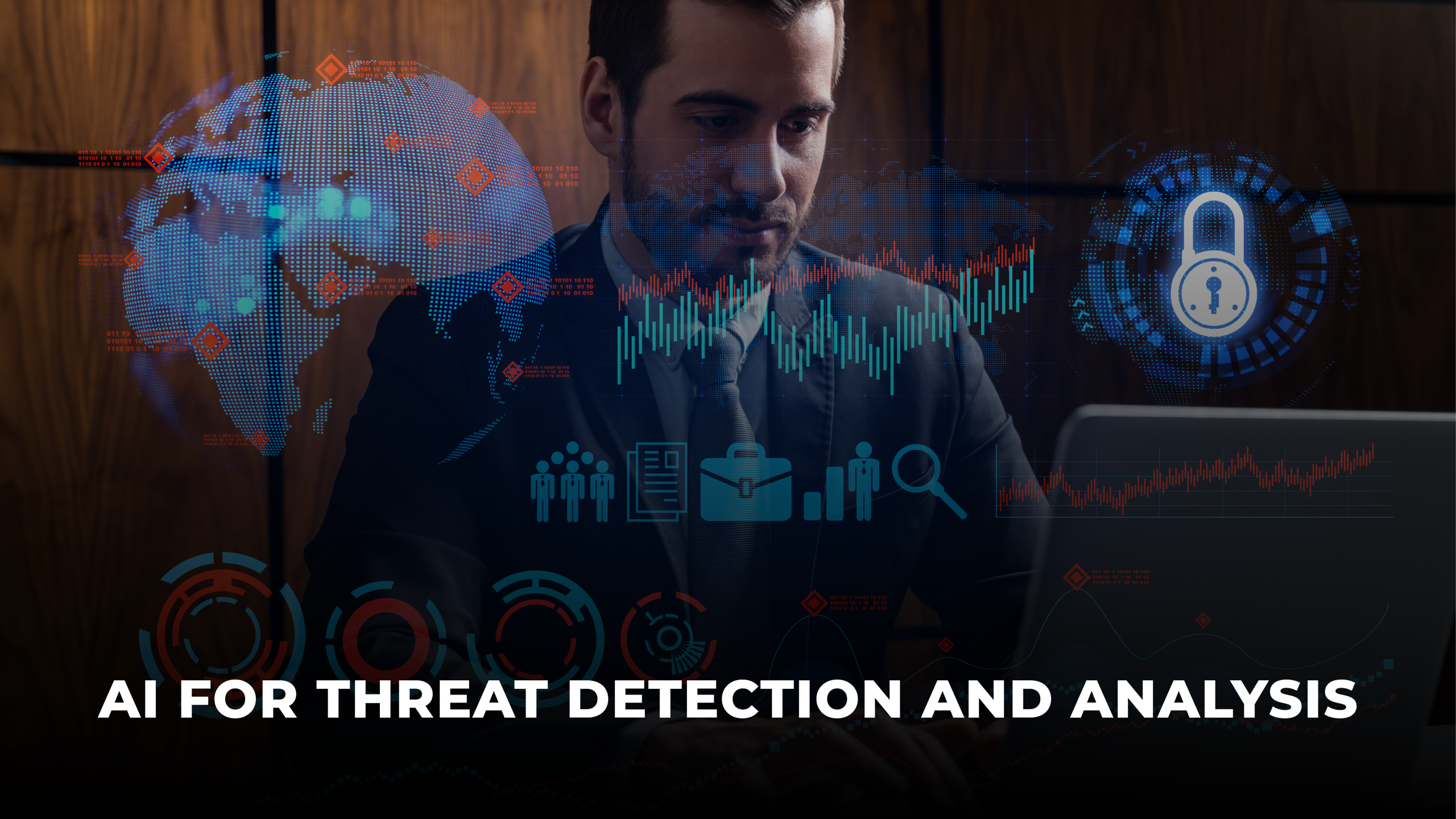AI for threat detection and analysis
In the contemporary digital environment, the threat landscape undergoes perpetual evolution. Cyber adversaries employ progressively intricate techniques for network intrusion, unauthorized data acquisition, and critical infrastructure disruption. Conventional security protocols frequently encounter challenges in synchronizing with the dynamic threat environment. Nevertheless, an emergent paradigm of innovation manifests in the deployment of Artificial Intelligence (AI) for the purposes of threat detection and analysis.
Quick Links
Transitioning from Reactivity to Proactivity: Maximizing AI’s Capabilities in Cybersecurity.
Security methodologies conventionally rely on signature-based detection for threat identification, leveraging recognized patterns. Despite its efficacy against established threats, this methodology frequently falters against zero-day attacks exploiting undisclosed vulnerabilities. AI, on the other hand, instigates a paradigmatic transformation by facilitating a proactive cybersecurity stance.
How AI Works its Magic: Unveiling the Mechanisms
AI for threat detection and analysis primarily leverages machine learning (ML) techniques. ML algorithms are trained on vast amounts of data, including network traffic logs, system events, and threat intelligence feeds. This data allows the algorithms to learn and identify patterns associated with malicious activity.
Domain AI operational mechanisms encompass the following pivotal attributes:
- Anomaly Detection: AI can analyze user behavior, network traffic, and system logs to identify deviations from normal activity patterns. Approaching the detection of irregular activities, such as unauthorized access endeavors or atypical data transmissions, may expose in-progress security breaches.
- Threat Prediction: By analyzing historical data and threat intelligence, AI can predict potential attack vectors and vulnerabilities within a system. This makes it easy for security teams to prioritize the efforts and To proactively address potential vulnerabilities before they can be exploited
- Automated Incident Response: AI can automate tasks associated with incident response, such as isolating compromised systems, quarantining threats, and notifying security personnel. This optimization conserves critical temporal and material assets, enabling security teams to concentrate on strategic decision-making and remedial endeavors.
AI-Enhanced Threat Analysis Beyond Traditional Detection Mechanisms
AI’s cybersecurity prowess transcends rudimentary threat detection via the deployment of advanced algorithms and machine learning. Through a multifaceted methodology, AI augments the holistic security stance. The ensuing delineation elucidates pivotal facets of AI’s input into an exhaustive cybersecurity framework:
- Threat Classification: AI utilizes parameter-based threat categorization, incorporating factors such as threat type, severity, and origin. Automated classification streamlines response prioritization for security teams. High-severity threats originating from identified malicious entities mandate prompt and targeted intervention, while lower-severity threats from less critical sources warrant a more measured response.
- Root Cause Analysis: Through data analysis, AI reconstructs event sequences preceding a security incident, crucial for breach root cause identification. Understanding attack unfolding enables organizations to address vulnerabilities and implement preventive measures. This proactive approach enhances cybersecurity infrastructure resilience.
- Attribution: In specific instances, AI serves to attribute a security incident to a particular source or malicious actor, proving pivotal for legal and law enforcement objectives. The identification of the attack’s origin not only aids in holding culpable entities accountable but also streamlines the initiation of legal proceedings against perpetrators of malicious activities. The capacity of AI to efficiently navigate extensive datasets and analyze complex patterns significantly enhances the precision and timeliness of attribution processes.
Embracing AI in Cybersecurity: A Technological Assessment of Advantages
The role of ai in cybersecurity yields substantial advantages:
- Increased Efficiency: AI can automate tedious tasks, freeing up security personnel to focus on more strategic initiatives.
- Improved Accuracy: AI’s ability to analyze vast amounts of data and identify subtle anomalies leads to more accurate threat detection, reducing the number of false positives that traditional methods generate.
- Faster Response Times: AI can automate certain aspects of incident response, enabling faster containment and mitigation of threats, minimizing potential damage.
- Enhanced Threat Intelligence: AI can continuously learn and adapt to new threats, improving the overall threat intelligence posture of an organization.
Challenges and Considerations in Responsible AI Implementation
Successful AI technology integration requires nuanced comprehension of limitations, emphasizing responsible deployment. Key considerations encompass:
- Data Quality: AI model efficacy is intricately tied to training data quality and quantity. Recognition and mitigation of dataset biases are imperative to prevent skewed outcomes. Deployment of diverse and precise datasets is crucial for augmenting model accuracy.
- Explainability: The inherent complexity of AI decision-making processes poses challenges in comprehending their logic. Embracing transparent and explainable AI models is essential, providing a means for human oversight. This mitigates the potential risks associated with biased or unpredictable decision outcomes.
- Security of AI Systems: AI systems are susceptible targets for malicious activities. Implementing strong security measures is essential to protect AI models and its data from manipulation or disruption. Ensuring the integrity and confidentiality of AI systems contributes to their overall reliability and resilience in the face of potential threats.
You May Also Read – Securing Solutions Amid The Journey To Digital Transformation
The Future of AI in Cybersecurity
Prospective AI trajectory in cybersecurity is marked by transformative advancements, indicating heightened capabilities and operational efficiency era. Rapid evolution of AI technology is driving substantial enhancement in the domain of threat detection and analysis. This progression anticipates a culmination in a synergistic human-AI collaboration, forming a potent alliance proficient at addressing dynamic cyber threats.
In this envisioned paradigm, human cybersecurity professionals persist in indispensable roles as strategic decision-makers and overseers. Their nuanced comprehension of organizational objectives, risk assessments, and contextual awareness synergizes with the computational prowess of AI. Simultaneously, AI algorithms assume responsibility for intricate and voluminous data analysis tasks, facilitating swift identification and mitigation of potential threats.The collaborative synergy between human intelligence and artificial intelligence (AI) presents the potential for a paradigm shift. Cybersecurity teams, wielding AI tools, gain enhanced capabilities to navigate the intricate and dynamic cyber threat landscape. The amalgamation of human intuition and AI’s precision ensures the establishment of a comprehensive and adaptive defense strategy.
Departing from conventional reactive methodologies, organizations integrating AI into cybersecurity operations will shift towards a proactive posture in countering cyber threats. AI’s autonomous analysis of extensive real-time datasets, pattern identification, and threat prediction empower organizations to foresee and preemptively thwart security breaches. This proactive approach not only strengthens organizational security postures but also cultivates a safer and more secure digital milieu for individuals, businesses, and societies.
By leveraging AI, organizations can establish robust digital defenses characterized by continual adaptation to emergent threats. The automation of mundane tasks emancipates human professionals, enabling a focus on strategic decision-making and addressing novel challenges. This symbiotic synergy between human expertise and AI not only enhances the effectiveness of cybersecurity measures but also strategically positions organizations to proactively traverse the dynamically evolving cyber threat landscape.
Conclusion
AI integration in cybersecurity aims to synergize human cognitive capabilities with machine operational efficiency, establishing a pivotal nexus for securing resilient digital fortifications, preventing the cyber threats, and raising secure digital ecosystem in the interconnected global landscape. As AI progresses continuously, the cybersecurity trajectory foretells a course characterized by empowerment, adaptability, and heightened defense against the ceaseless challenges of the digital era.
Author’s Bio:
With our best tech publication, Ciente , business leaders stay abreast of tech news and market insights that help them level up now.
Technology spending is increasing, but so is buyer’s remorse. We are here to change that. Founded on truth, accuracy, and tech prowess, Ciente is your go-to periodical for effective decision-making.
Our comprehensive editorial coverage, market analysis, and tech insights empower you to make smarter decisions to fuel growth and innovation across your enterprise.
Let us help you navigate the rapidly evolving world of technology and turn it to your advantage.
How to Manage Multiple Reddit Accounts
Reddit is more than just a social platform; with 82% of Zoomers trusting the platform’s review,…
0 Comments3 Minutes
6 Ways to Fund Your Digital Marketing Business
Digital marketing is one of the most lucrative online careers, but just like any industry, there…
0 Comments7 Minutes
Web Application Development: Trends and Best Practices 2024
Web applications are the solutions that are at the core of today’s enterprises. The fast pace of…
0 Comments8 Minutes
How Insights are Reshaping Marketing Strategies
In today's competitive marketplace, data-driven insights have emerged as one of the strongest…
0 Comments5 Minutes
Top Benefits of Having a Skilled Webflow Team
With a website today being the virtual version of a shop within the digital world, in reality, it…
0 Comments9 Minutes
The Impact of AI on SEO in 2024 and Best Practices
In 2024, AI is not just another trend in SEO; it’s a transformative tool that's reshaping digital…
0 Comments4 Minutes
Boost Your Search Rankings with These Free Keyword Tools
Introduction In these days’s competitive virtual panorama, SEO plays an essential role in riding…
0 Comments10 Minutes
How Web Accessibility Impacts SEO: Optimizing for Screen Readers and Beyond – An Overview
The term web accessibility refers to providing websites for all users to access, no matter the…
0 Comments14 Minutes








